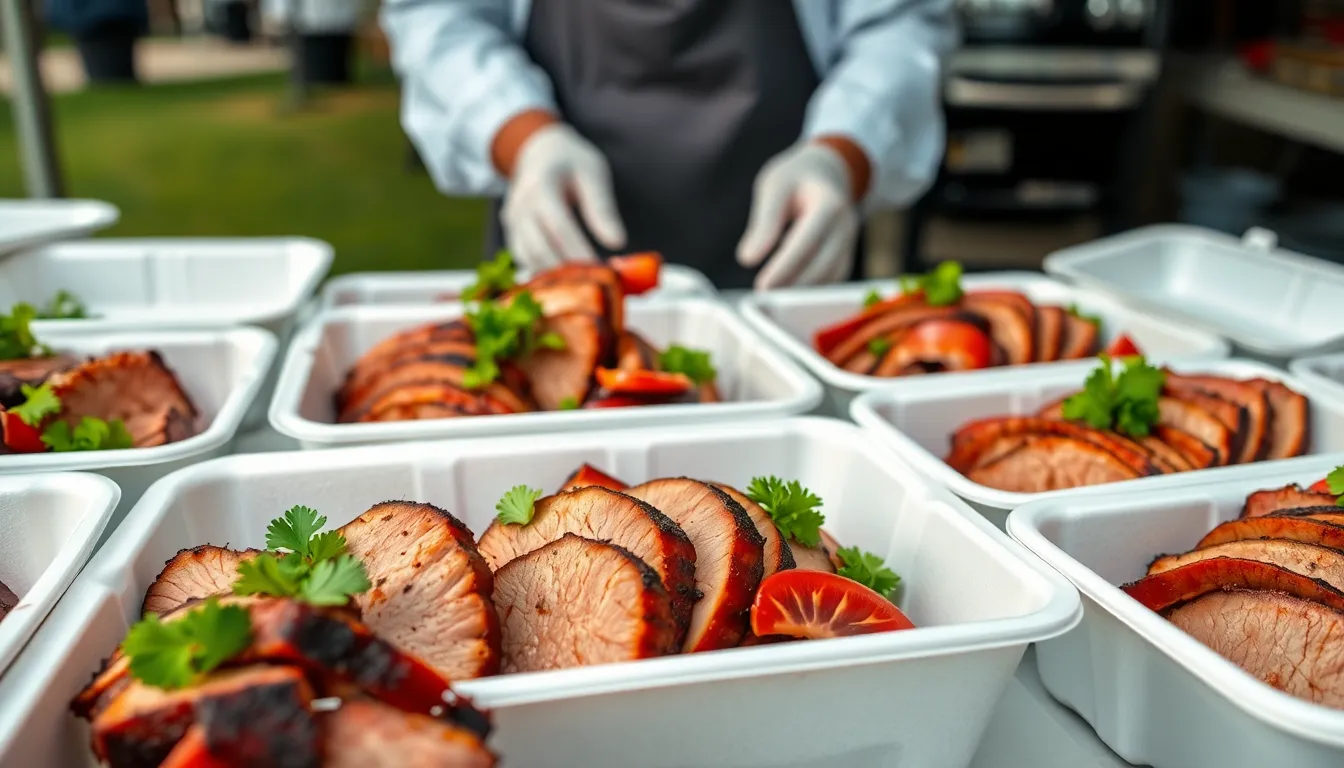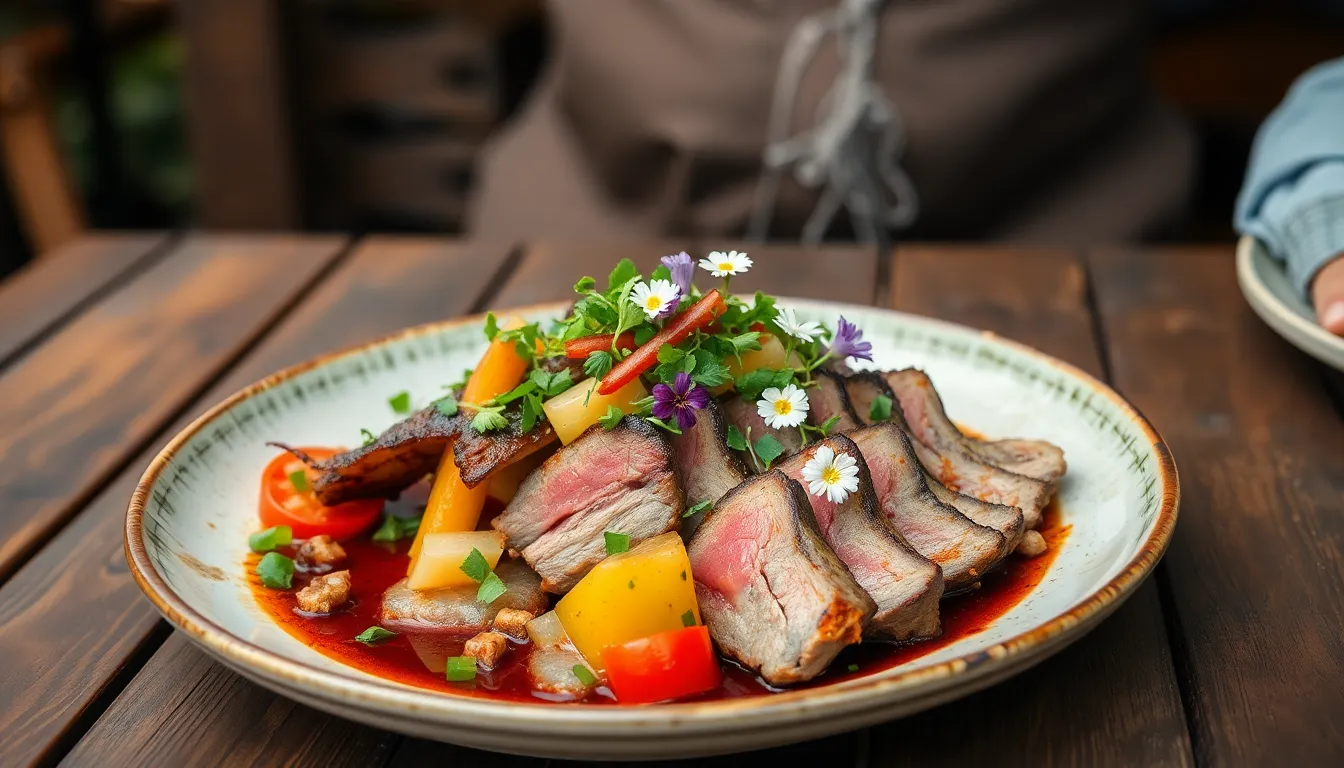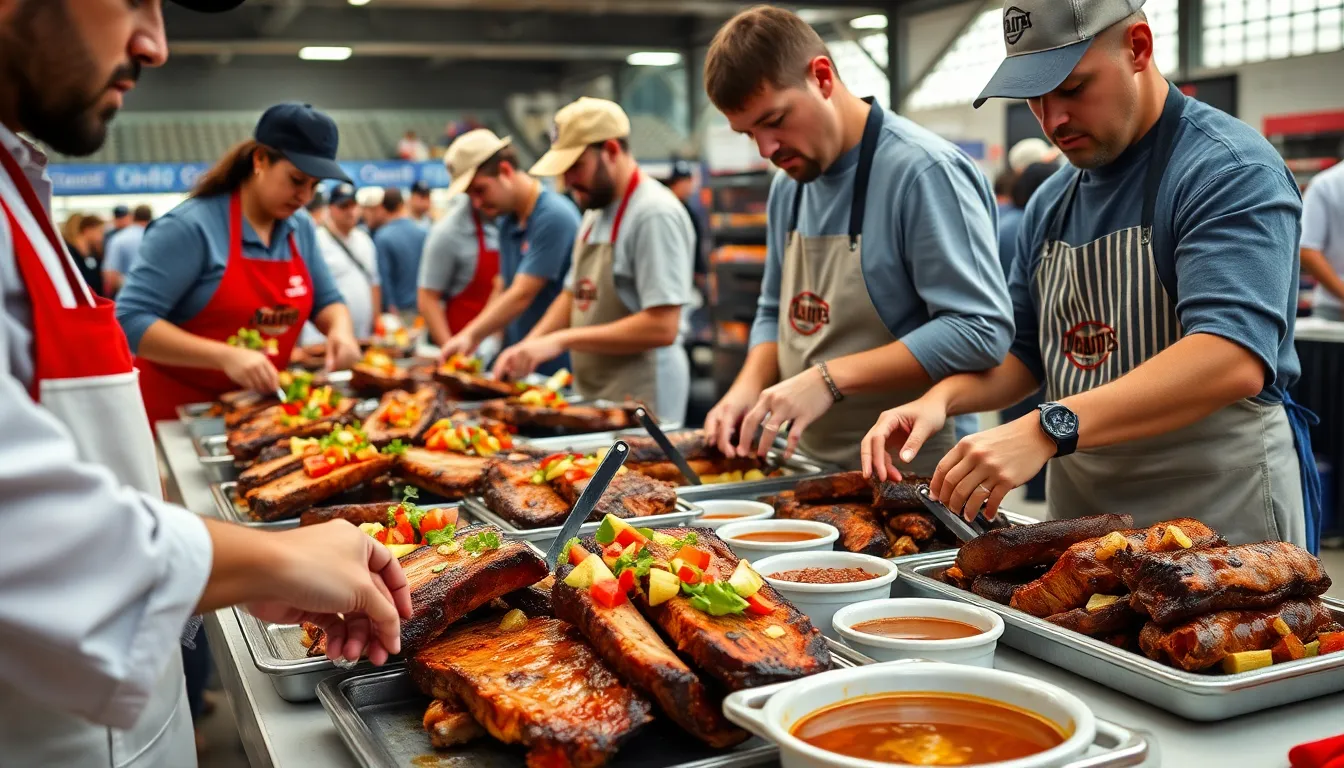We’ve all tasted incredible BBQ that deserved to win but watched it lose to a lesser dish with stunning presentation. In the competitive industry of BBQ contests, flavor alone won’t guarantee victory – visual appeal often makes the difference between first place and going home empty-handed.
Great BBQ competition presentation isn’t about fancy garnishes or restaurant-style plating. It’s about showcasing your perfectly smoked meats in ways that make judges’ mouths water before they take their first bite. From strategic color contrasts to professional-looking turn-in boxes, the right presentation techniques can elevate your competition game significantly.
Whether you’re a weekend warrior entering your first contest or a seasoned pitmaster looking to refine your approach, we’ll share proven presentation strategies that winning teams use to make their BBQ irresistible. These aren’t just pretty tricks – they’re competition-tested methods that help judges see the quality and care you’ve put into every bite.
Master the Art of Color Contrast in Your BBQ Competition Presentation
Visual impact separates winning entries from average ones in BBQ competitions. Smart color choices make your smoked meats appear more appetizing and professional to judges.
Use Vibrant Garnishes to Create Visual Pop
Fresh herbs transform bland presentation boxes into eye-catching displays that command attention. We’ve seen teams use bright green parsley, cilantro, and chives to create stunning contrast against dark brisket and ribs. Colorful vegetables like cherry tomatoes, bell pepper strips, and radish slices add natural vibrancy without overwhelming the meat.
Strategic placement matters more than quantity when selecting garnishes for competition boxes. Position bright orange carrot curls near darker pulled pork to create dramatic visual separation. Place red bell pepper strips alongside pale chicken to enhance the protein’s golden color. Small amounts of purple cabbage work exceptionally well as borders around beef entries.
Edible flowers elevate presentation quality while maintaining competition standards that require all garnishes to be food-safe. Nasturtiums provide orange and yellow pops of color that complement smoky flavors. Pansies offer purple and white options that create sophisticated contrast patterns. Microgreens deliver intense green color in compact spaces.
Balance Dark Meats with Bright Side Dishes
Strategic side selection creates visual harmony between proteins and accompaniments in competition entries. We recommend pairing dark brisket with bright white coleslaw or vibrant corn salad to establish clear color boundaries. Yellow mac and cheese provides excellent contrast against blackened ribs while maintaining comfort food appeal.
Portion sizing affects overall color balance in presentation boxes more than most teams realize. Small portions of brightly colored sides prevent overwhelming the main protein while still providing necessary visual relief. Quarter-cup servings of orange sweet potato salad or green bean almondine create perfect accent portions. Red baked beans work effectively in small quantities alongside pulled pork.
Color wheel principles guide successful side dish combinations that judges find visually appealing. Complementary colors like orange carrots with blue-purple cabbage create maximum visual impact. Analogous colors such as red tomatoes with orange peppers provide harmonious yet interesting contrast. Green vegetables paired with red meats follow classic color theory that appeals to most viewers.
Incorporate Colorful Sauces for Strategic Accent Points
Sauce placement requires precision to enhance rather than mask your carefully prepared BBQ entries. We apply bright red sauce in thin lines along box edges to frame the presentation without covering meat surfaces. Golden mustard-based sauces work perfectly as small dots around chicken pieces to add color variation. White Alabama sauce creates striking contrast when drizzled lightly over dark pork.
Multiple sauce colors create professional-looking presentations that demonstrate culinary sophistication to competition judges. Three-sauce combinations using red, white, and green options provide maximum visual interest while staying within traditional BBQ flavor profiles. Dark brown molasses-based sauces pair beautifully with bright yellow mustard versions for two-tone effects.
Application techniques determine whether colorful sauces enhance or detract from your BBQ competition presentation. Squeeze bottles allow precise dot patterns and clean lines that look intentional rather than messy. Small spoons create perfect sauce pools in designated areas of presentation boxes. Brush applications work best for creating subtle color washes across meat surfaces without overwhelming the protein.
Perfect Your Plating Techniques for Maximum Visual Impact

Professional plating techniques separate winning BBQ presentations from average ones. We’ll show you three fundamental methods that consistently impress competition judges.
Apply the Rule of Thirds for Professional Composition
Dividing your competition box into imaginary thirds creates naturally appealing arrangements. We mentally split the container both horizontally and vertically, forming nine equal sections that guide our placement decisions.
Positioning meat pieces along these invisible lines draws judges’ eyes to focal points automatically. Strategic placement at line intersections creates the most visual impact, making your BBQ presentation look professionally composed rather than randomly arranged.
Balancing elements across these thirds prevents clustering that can make boxes appear messy. We avoid placing all items in the center, instead distributing them according to the rule of thirds for maximum visual appeal.
Create Height and Dimension with Strategic Stacking
Building vertical elements transforms flat presentations into ever-changing displays. We stack ribs and larger meat pieces to create multiple levels that catch judges’ attention immediately.
Using the natural curves of meat helps us construct stable layers without looking forced. Bone-in cuts like ribs naturally create height when overlapped slightly, adding three-dimensional appeal to our competition boxes.
Varying the heights across different sections prevents monotonous flat arrangements. We combine taller stacked elements with lower profile pieces to create visual rhythm throughout the presentation.
Use Negative Space to Let Your BBQ Shine
Empty space around meat pieces allows each element to stand out clearly. We resist the urge to fill every inch of our competition box, instead leaving strategic gaps that highlight our BBQ’s texture and color.
Proper spacing between pieces helps judges distinguish individual items easily. Overcrowded presentations blur together visually, while thoughtful spacing creates clean lines that showcase our smoking skills effectively.
White space makes meat appear more appetizing by preventing visual clutter. We use negative space as a design element itself, creating breathing room that lets our perfectly smoked BBQ command attention.
Choose the Right Serving Containers and Platters

The foundation of winning BBQ presentation starts with selecting proper containers and platters that meet competition standards. Your presentation strategy means nothing if you’re using non-approved containers that result in disqualification.
Select Contest-Approved Presentation Boxes
Contest rules dictate exact container requirements that vary between sanctioning bodies like KCBS and SCA. We recommend studying your competition’s guidelines thoroughly since KCBS often requires clamshell Styrofoam boxes while other contests may allow custom platters.
Practice becomes essential when working with approved containers to ensure clean, attractive presentations that fit within size restrictions. Most competitions limit container dimensions to 18 inches maximum, creating space constraints that require strategic planning.
Table captains need to carry your presentation easily, so we suggest testing your setup beforehand to avoid handling issues during judging. Violating container specifications results in point deductions or complete disqualification from your category.
Coordinate Colors That Complement Your Food
Garnish selection should enhance your smoked meats without creating visual competition on the plate. We use fresh parsley or lettuce sparingly to add color contrast that makes dark, rich BBQ stand out effectively.
Green garnishes work particularly well with smoked meats because they provide brightness against the deep, caramelized colors. Avoid over-saucing your presentation since excessive sauce can mask the meat’s natural appeal and create messy appearances.
Burnt pieces detract from overall presentation quality, so we trim any charred edges before plating. Color coordination extends beyond garnishes to include sauce placement that complements rather than overwhelms your BBQ.
Consider Size and Portion Requirements
Uniform portioning demonstrates technical skill while meeting exact competition requirements for each category. We prepare identical meat slices or portions that show consistency in thickness and size across all submissions.
Brisket slices require particular attention to uniformity since judges evaluate visual consistency alongside taste and tenderness. Competition rules typically mandate 8 or 12 identical portions depending on your entered category.
Symmetrical arrangements create professional presentations that appeal to judges’ visual expectations. We ensure each portion meets minimum size requirements while maintaining the proper meat-to-presentation ratio that showcases our smoking abilities.
Enhance Your Presentation with Strategic Garnishing

Smart garnishing transforms ordinary BBQ plates into competition-winning presentations. Strategic placement of fresh elements creates visual contrast while adding complementary flavors that enhance the overall judging experience.
Add Fresh Herbs for Color and Aroma
Fresh herbs deliver vibrant green color that contrasts beautifully with BBQ meats’ rich, dark tones. Parsley, cilantro, and thyme work exceptionally well because they provide aromatic enhancement without overpowering smoky flavors.
Place herbs strategically around meat portions to create natural color balance. We recommend using small sprigs rather than chopped herbs to maintain visual impact and prevent the garnish from looking messy or accidental.
Consider the herb’s flavor profile when making selections. Cilantro pairs wonderfully with pork dishes, while thyme complements beef perfectly. This thoughtful approach shows judges you’ve considered every aspect of the presentation.
Use Pickled Vegetables as Flavor and Visual Elements
Pickled vegetables introduce bright, vibrant colors while providing tangy flavor contrast that cuts through rich BBQ. Pickled cucumbers, onions, and carrots work particularly well because they maintain their crunch and visual appeal throughout the judging process.
Arrange pickled elements to create color pops that draw the eye around the plate. We suggest using them as accent pieces rather than dominant features to maintain proper meat-to-garnish ratios.
Balance is crucial when using pickled vegetables. Their sharpness helps cleanse the palate between meat samples, giving judges a fresh perspective on each bite. This technique demonstrates understanding of flavor profiles and shows attention to the complete tasting experience.
Incorporate Edible Flowers for Premium Appeal
Edible flowers elevate presentations with delicate colors and sophisticated elegance that signals premium attention to detail. Nasturtiums and pansies provide safe, beautiful options that brighten dishes without overwhelming the primary components.
Select flowers that complement your BBQ’s color scheme and flavor profile. We recommend using 2-3 small flowers maximum to avoid creating a presentation that looks more like a garden than a BBQ competition entry.
Position flowers as focal points that guide the judge’s eye to your best meat cuts. Their premium appearance communicates creativity and professional presentation skills, helping your entry stand out in crowded competition fields.
Master Professional Food Styling Techniques

We’ll now focus on the exact techniques that transform good BBQ into competition-winning presentations. These professional methods require precision and practice to execute effectively.
Apply Oil or Butter for Appetizing Shine
Adding a light coating of oil or butter to your smoked meats creates the glossy finish that catches judges’ eyes immediately. We recommend using a pastry brush or paper towel to apply just enough oil to create a subtle sheen without making the meat appear greasy. This technique works particularly well on brisket slices and pork ribs where the enhanced appearance makes the meat look freshly cooked and juicy.
Butter provides a slightly richer appearance than oil and can enhance the color depth of darker meats. We suggest applying this finishing touch just before placing the meat in your competition box to ensure maximum visual impact when judges first see your entry.
Use Tweezers for Precise Garnish Placement
Professional-grade tweezers give us the control needed for exact garnish positioning and meat arrangement in competition boxes. These tools allow us to place small herbs, adjust meat pieces, and create symmetrical patterns without disturbing surrounding elements. We can achieve the precise placement that separates amateur presentations from professional-looking entries.
Small tongs work as an alternative to tweezers for larger pieces, but we find that tweezers provide better control for detailed work. This level of precision prevents the messy or uneven appearance that can cost points in competition judging.
Create Clean Lines and Sharp Edges
Uniform slicing creates the foundation for professional BBQ presentation, with each piece cut to identical thickness and size. We must ensure our knife skills produce clean, straight cuts that showcase our technical abilities to judges. This attention to detail demonstrates the precision that competition BBQ demands.
Careful arrangement in the competition container maintains these clean lines throughout the presentation process. We avoid overcrowding by giving each piece adequate space while maintaining a tight, organized pattern that looks intentional and appealing. The best-looking pieces should be positioned on top where they’ll make the strongest first impression on judges.
Develop a Signature Presentation Style

Developing a signature presentation style transforms our BBQ from good to unforgettable in competition settings. We’ll build a recognizable visual brand that judges remember long after tasting our entries.
Create Consistent Branding Across All Categories
Standardizing presentation elements across pork, beef, chicken, and ribs creates our unique competitive identity. We should use identical garnish types, plating techniques, and container arrangements for every category we enter.
Following competition rules closely ensures our branding stays within acceptable parameters while maximizing visual impact. Each sanctioning body has different requirements for box versus platter presentations, so we’ll adapt our signature style to meet these exact guidelines.
Building recognition through repetition helps judges associate our distinctive look with quality BBQ. We can achieve this by selecting one primary garnish style, maintaining consistent meat arrangement patterns, and using similar color schemes across all our entries.
Design Memorable Plating Patterns
Using garnishes wisely means creating that signature “putting green” effect with romaine lettuce as our base layer topped with fresh parsley. This combination lifts our meat visually while adding vibrant color contrast that makes our entries pop.
Avoiding overdone presentations keeps the focus squarely on our BBQ rather than distracting decorative elements. We’ll incorporate clean, simple plating that complements rather than competes with our smoked meats.
Highlighting key features requires showing at least one rib with its cross section visible and arranging brisket slices in uniform, neat patterns. These strategic displays draw judges’ attention to the smoke ring, bark, and texture that demonstrate our cooking skills.
Establish Your Unique Visual Identity
Visual consistency sets us apart while staying within competition guidelines through exact garnish choices, distinctive stacking styles, or memorable box layouts. We’ll develop signature touches that become our calling card at competitions.
Signature elements might include a particular garnish pattern, custom presentation technique, or unique meat arrangement that judges can identify as ours. These small but distinctive details help establish brand recognition among the competition circuit.
Ensuring practicality means our visual identity must remain transportable and judge friendly. We’ll avoid overly fragile arrangements or complex setups that might fall apart during transport, keeping our signature style both beautiful and functional for competition success.
Time Your Presentation for Optimal Freshness

Mastering timing separates winning teams from those who simply participate. Strategic coordination ensures your BBQ reaches judges at peak quality when it matters most.
Plan Your Assembly Timeline Strategically
Organization becomes critical when working within competition time constraints. We recommend creating a detailed timeline that accounts for the 10-minute turn-in window, which typically allows 5 minutes before to 5 minutes after your scheduled submission time. Missing this window results in automatic disqualification, making precise planning essential.
Build your workflow around peak freshness moments. Complete all major cooking steps well before assembly begins, allowing time for meat to rest while maintaining optimal temperature and moisture. This approach prevents rushed preparation that can compromise presentation quality.
Prepare garnishes and sides in advance while keeping assembly components separate. Fresh herbs, colorful vegetables, and sauce components should be ready but not applied until the final moments. This strategy maintains visual appeal and prevents ingredients from wilting or losing their vibrant appearance.
Coordinate your team’s responsibilities to create smooth execution. Assign exact tasks like slicing, plating, and garnishing to different team members to maximize efficiency during the critical assembly period.
Keep Components at Proper Temperatures
Temperature control directly impacts both taste and texture during judging. Maintain cooked meat at warm temperatures without creating excess steam, which can negatively affect appearance and mouthfeel. Steaming meat often appears less appetizing and can alter the carefully developed bark texture.
Transport strategies prevent temperature fluctuations that compromise quality. Use insulated containers or warming methods to maintain consistent temperatures from cooking area to turn-in location. Dramatic temperature changes can affect tenderness and alter the flavor profile judges expect.
Monitor internal temperatures throughout the assembly process. Meat that becomes too cool loses appeal, while overheated entries can appear dried out or unappetizing in the competition box.
Execute Final Touches Just Before Judging
Apply glazes and finishing sauces moments before submission for maximum impact. Fresh applications create glossy, appetizing surfaces that catch judges’ attention immediately. Sauces applied too early can soak into the meat or create uneven coverage.
Perfect your meat texture presentations in the final minutes. Ribs should demonstrate a clean bite that exposes bone only at the bite point, while brisket slices need slight resistance without falling apart. These texture indicators signal proper cooking technique to experienced judges.
Remove any inedible items that cause automatic disqualification. Toothpicks, plastic garnishes, or non-food decorations must be eliminated before turn-in. Even small oversights in this area can eliminate otherwise winning entries from consideration.
Perform final visual inspections to ensure professional presentation standards. Check for proper portion sizes, clean box edges, and strategic garnish placement that enhances rather than overwhelms your BBQ components.
Conclusion
Mastering BBQ competition presentation isn’t just about making food look pretty – it’s about creating a complete sensory experience that captures judges’ attention and showcases our culinary skills. When we combine strategic color choices with professional plating techniques and consistent branding we transform ordinary smoked meats into competition-winning entries.
The key lies in balancing visual appeal with practical execution. By developing our signature style and perfecting our timing we ensure that every element works together harmoniously. Remember that judges eat with their eyes first so every garnish placement and color contrast we choose directly impacts our scores.
These presentation strategies give us the competitive edge needed to stand out in today’s challenging BBQ circuit. With practice and attention to detail we can elevate our competition game and consistently deliver presentations that wow judges and secure those coveted trophies.
Frequently Asked Questions
Why is presentation important in BBQ competitions beyond just flavor?
Presentation significantly influences judges’ decisions in BBQ competitions. Visual appeal can make the difference between victory and defeat, as judges often eat with their eyes first. Even perfectly smoked meat with excellent flavor can lose to visually appealing entries. Effective presentation showcases your BBQ skills and demonstrates attention to detail that separates amateur competitors from champions.
What are the most effective color contrast techniques for BBQ presentation?
Use vibrant garnishes like fresh herbs, colorful vegetables, and bright sauces to create visual impact against dark smoked meats. Balance heavy, dark proteins with lighter-colored side dishes and strategically place colorful elements to enhance visual harmony. Avoid overwhelming the meat – the goal is to complement and highlight your BBQ, not overshadow it with excessive decoration.
How does the Rule of Thirds apply to BBQ competition plating?
The Rule of Thirds involves dividing your competition box into imaginary thirds, both horizontally and vertically. Place key elements along these lines or at intersection points to create naturally appealing compositions. This technique prevents centered, static arrangements and creates dynamic visual interest that draws judges’ attention to your BBQ presentation.
What containers and platters are acceptable for BBQ competitions?
Competition containers must meet specific sanctioning body requirements, as using non-approved containers can result in disqualification. Study contest rules thoroughly since requirements vary between organizations like KCBS, IBCA, and others. Choose containers that complement your food’s colors and maintain professional appearance while meeting all competition standards and regulations.
How important is uniform portioning in BBQ competition presentation?
Uniform portioning demonstrates technical skill and professionalism to judges. Brisket slices should be consistent in thickness and size, while other proteins should show similar attention to detail. Consistent portioning creates visual harmony and meets competition requirements, showing judges that you have complete control over your cooking and presentation techniques.
What are the best garnishing techniques for BBQ competitions?
Use fresh herbs for color and aroma, pickled vegetables for flavor contrast, and edible flowers for premium appeal. Place garnishes strategically to create visual balance without overwhelming the meat. Choose elements that complement rather than compete with your BBQ’s appearance. Keep garnishes simple, fresh, and purposeful to enhance the overall judging experience.
How can competitors develop a signature presentation style?
Create consistent branding across all categories using identical garnish types and plating techniques. Develop memorable plating patterns that highlight your BBQ’s key features while maintaining practical transportability. Establish unique visual identity with signature touches that build recognition among judges, making your entries stand out throughout the competition circuit.
What timing considerations are crucial for BBQ competition presentation?
Plan your assembly timeline to ensure BBQ reaches judges at peak quality. Organize workflows to maintain proper temperature control and freshness. Execute final touches just before judging to maximize visual appeal. Monitor internal temperatures and perform final inspections to meet professional standards. Strategic timing prevents dried-out meat and maintains optimal presentation quality.







